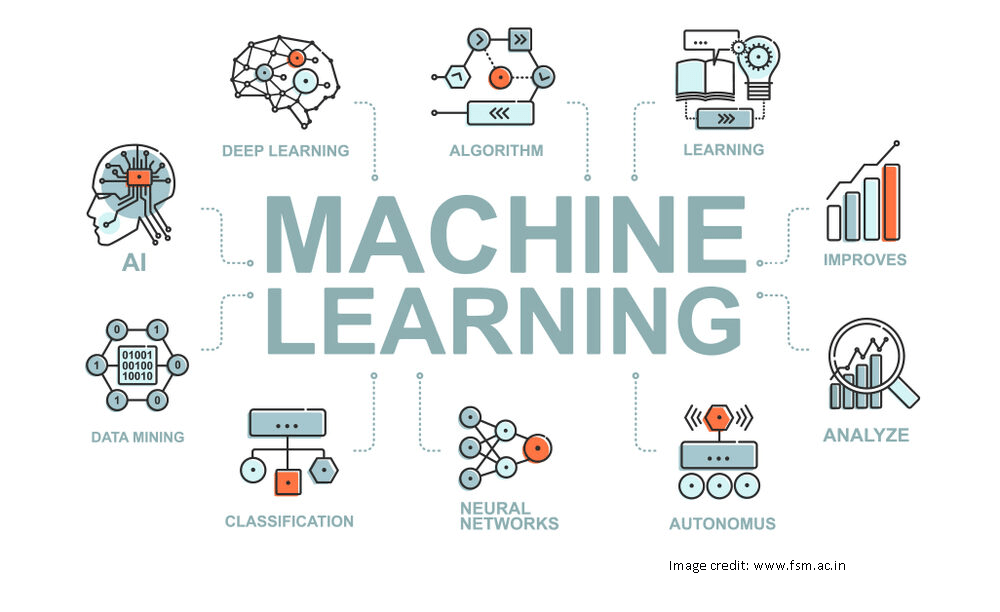What is ML?
Machine Learning is a subfield of artificial intelligence (AI) that focuses on developing algorithms and models that enable computers to learn and make predictions or decisions without being explicitly programmed. It involves the study of computer algorithms and statistical models that allow systems to analyze and interpret complex patterns and relationships in data automatically.

Machine learning in a nutshell
The core idea behind machine learning is to enable computers to learn from data and improve their performance on a specific task over time. Instead of explicitly programming a computer to perform a particular task, machine learning algorithms are designed to learn from examples or experiences and make predictions or take actions based on that learned information.
There are several types of machine learning techniques, including:
- Supervised Learning: In this approach, the algorithm is trained on labelled data, where the correct output accompanies the input data. The algorithm learns from these examples and generalizes the mapping between inputs and outputs to make predictions or classifications on unseen data.
- Unsupervised Learning: Unlike supervised learning, unsupervised learning algorithms are trained on unlabeled data. The algorithm learns to find patterns, structures, or relationships in the data without predefined labels or targets. Clustering and dimensionality reduction are everyday tasks in unsupervised learning.
- Reinforcement Learning: This type of learning involves an agent that learns to interact with an environment and improve its performance based on feedback in the form of rewards or punishments. The agent learns through trial and error, exploring different actions and learning from the consequences.
Use of machine learning
Machine learning involves developing algorithms to learn from data. Machine learning uses statistical methods to discover patterns in data and make predictions about new examples, often unsupervised.
Machine learning has several subfields, including:
- Image recognition
- Speech recognition
- Natural language processing (NLP)
- Recommender systems
- Tensorflow (Machine Learning tool from Google)
Advantages of machine learning:
Machine learning is a subfield of artificial intelligence in which computers are trained to perform tasks that require “learning” by analyzing data. The field emerged from the study of recognising patterns in large amounts of data. The two most common types of machine learning are supervised and unsupervised learning. Supervised learning involves providing an algorithm with labelled examples or training data, such as when we show our dog to an unfamiliar person on a leash and ask him/her whether or not it’s friendly. Unsupervised learning involves giving an algorithm unlabeled examples or raw information without any known structure; this type has been used in many areas, such as image processing, speech recognition, natural language processing (NLP), social network filtering (SNSF), medical diagnosis etc.,
Related Topic: Big Query ML
bigquery ml
BigQuery ML is a machine learning (ML) service provided by Google Cloud Platform (GCP). It allows you to create and execute machine learning models directly within BigQuery, Google’s serverless data warehouse. With BigQuery ML, you can perform various ML tasks, such as classification, regression, and forecasting, using SQL queries.
Related Technology: TensorFlow
TensorFlow is an open-source machine learning framework developed by Google. It provides a comprehensive ecosystem of tools, libraries, and resources for building and deploying machine learning models. TensorFlow is widely used in research and industry due to its flexibility, scalability, and extensive support for various platforms and devices.
At its core, TensorFlow is based on the concept of computational graphs. A computational graph is a series of operations arranged in a directed graph, where nodes represent operations and edges represent the data flow between operations. This graph-based approach allows for efficient execution and parallelization of computations, especially on hardware accelerators like GPUs (Graphics Processing Units) and TPUs (Tensor Processing Units).
Key features and components of TensorFlow include:
- TensorFlow Core: It provides a programming interface in various languages (primarily Python) for building and executing machine learning models. TensorFlow Core has many built-in functions and operations for mathematical computations, neural networks, optimization, and data manipulation.
- High-level APIs: TensorFlow offers high-level APIs, such as Keras, which simplify the process of building and training neural networks. Keras provides a user-friendly and intuitive interface for defining network architectures, specifying layers, and configuring training parameters.
- TensorFlow Extended (TFX): TFX is a set of libraries and tools built on top of TensorFlow to support the end-to-end machine learning pipeline, including data ingestion, preprocessing, model training, evaluation, and serving.
- TensorFlow Serving: A flexible and efficient system for deploying trained TensorFlow models in production environments. It allows seamless integration with various deployment scenarios, such as serving models via RESTful APIs or as part of a distributed system.
- TensorFlow Lite: TensorFlow Lite is a lightweight version of TensorFlow explicitly designed for mobile and embedded devices. It enables the deployment of machine learning models on resource-constrained platforms, such as smartphones, IoT devices, and edge devices.
- TensorFlow Hub: TensorFlow Hub provides a repository of pre-trained models, embeddings, and modules that can be easily integrated into new projects. It allows developers to leverage existing models and transfer learning techniques to accelerate model development.
Conclusion
Machine learning is a field of study that has grown tremendously in recent years and is now more accessible than ever. The ability to understand complicated data sets with just a few lines of code makes machine learning an attractive option for many businesses that want their systems to become more innovative.
References:
- AI Technologies
- TensorFlow in Machine Learning – https://developers.google.com/machine-learning/crash-course/first-steps-with-tensorflow/toolkit
- AutoML AWS – (AWS Machine Learning Services)
- https://mitsloan.mit.edu/ideas-made-to-matter/machine-learning-explained
- https://en.wikipedia.org/wiki/Machine_learning
- https://www.collegelib.com/what-is-machine-learning/
Related articles:
- What is Machine Learning?
- What is Artificial Intelligence (AI)?
- Artificial intelligence and Machine Learning
- Data mining system
- ChatGPT Reinforcement Learning from Human Feedback (RLHF AI)
Collegelib.com prepared and published this curated article on Machine Learning for Engineering topic preparation. Before shortlisting your topic, you should do your research in addition to this information. Please include Reference: Collegelib.com and link back to Collegelib in your work.